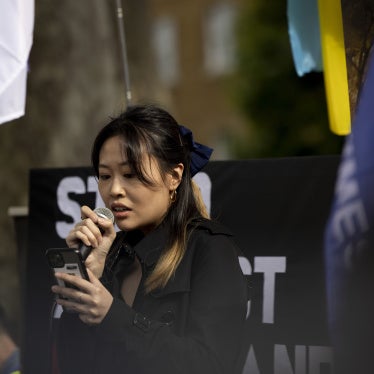(Washington, DC) - The Chinese, Indian, and Nepali governments should release detained Tibetans and permit them to demonstrate peacefully, Human Rights Watch said today.
Protesters in Lhasa, Tibet, Dharamsala, India and Kathmandu, Nepal who were attempting to observe “Tibetan National Uprising Day,” the anniversary of the Tibetan rebellion against Beijing’s rule in Tibet in 1959, were dispersed and arrested. The protests in Lhasa were the largest political demonstrations there since 1989.
“Instead of arresting peaceful protesters, why don’t these governments meet with them and attempt to address their grievances?” said Sophie Richardson, Asia advocacy director at Human Rights Watch. “Peaceful demonstrations are protected under international and domestic laws and they should be permitted, not violently dispersed.”
On March 10, 2008, hundreds of monks from Drepung monastery, five miles west of the Tibetan capital Lhasa, began peaceful protests calling for an end to religious restrictions and release of imprisoned monks. While marching toward the city center, the Drepung protesters were stopped by large numbers of Chinese police, and media reports estimated that around 50 monks were detained. The monks held a sit-down protest for some 12 hours before returning to their monastery, access to which now appears to have been cut off. On March 11 at around 2:30 a.m., the sound of gunfire was heard emanating from the area of the monastery. Also on March 10, up to 14 monks from Sera monastery and three laymen and women were detained during a protest in the city center where they called for independence and waved the forbidden Tibetan flag.
On March 11, 500-600 protesting monks from the nearby Sera monastery, two miles north of Lhasa, called for the release of the monks arrested a day earlier. The Sera monks, who attempted to march into Lhasa city, were met by approximately 2,000 armed police. According to Radio Free Asia, security forces used tear gas to disperse the crowd. At that point, the monks staged a peaceful seven-hour sit-in. Three were detained and eventually released, but there are unconfirmed reports that a hunger strike has begun inside the monastery.
Protests have also taken place in other parts of the country. On March 11, Chinese security forces reportedly surrounded Ditsa monastery in Bayan County (Chinese: Hualong) in Qinghai province after the monks there held a pro-independence protest. The People’s Armed Police surrounded the Ganden monastery near Lhasa after a protest there on March 12. Phone lines to the monastery have been cut. There are media reports that around 12 monks have been arrested following an incident in Rebkong, Qinghai.
Over the past half-century, the Chinese government has arrested, detained, and tortured countless Tibetans – including monks, nuns and children – protesting Chinese rule intended to quash alleged “separatism.” The Chinese government accuses the Dalai Lama, in exile in India since 1959, of being the linchpin of alleged plots to separate Tibet from China, and it views Tibetan Buddhism as complicit in those efforts.
“We are witnessing the most visible wave of peaceful dissent against Chinese rule in the Tibetan capital for the past two decades,” said Richardson. “What is unusual is the harsh crackdown on similar protests in democratic India and Nepal, which raises concerns about whether China is pressuring those countries to silence Tibetans.”
On March 10, Indian police detained 100 exiled Tibetans who attempted to march to Tibet from Dharamsala, the site of the Tibetan government-in-exile, in Kangra District in India. On the same afternoon, Indian police issued a restraining order barring the protesters from leaving the district. Three days later, Indian police forced the marchers to stop, loaded them onto police buses and are holding them at the Jawalaji police station. Tenzin Tsundue, one of the leaders of the march, is being held separately from the other detainees.
“The Indian police should immediately release the marchers detained, lift the restraining order and the allow the march to continue peacefully,” Richardson said. “Any reaction by the Indian government must be proportionate to the threat posed to law and order.”
Tibetan refugees living in India have traditionally been provided a safe haven by the government, but are required to inform the authorities when they leave the area of declared residence.
On March 10, Nepal’s metropolitan and armed police force violently suppressed demonstrators in Kathmandu with more than 150 Tibetans arbitrarily detained for several hours in Gau Shala, Kamal Pokhari and Boudha police stations. Human Rights Watch is gravely concerned by reports of beatings of the 14 individuals detained at Boudha police station. One of the detainees told Human Rights Watch that:
“We were kicked, punched, slapped and had our hair pulled for around 15-20 minutes. This included two women and two nuns. Our names were registered and we were verbally abused and threatened that we would be handed over to China.”
Many Tibetans who arrived in Nepal before December 31, 1989 are officially regarded as refugees. But the Nepali government has refused to register as refugees Tibetan asylum seekers arriving after that time. As a result, new arrivals are at risk of summary repatriation and encounter great difficulty integrating into Nepali society and accessing education, health care, and employment. It is also impossible for them to leave the country unless granted an exit permit. In January 2005, under pressure from the Chinese government, the Nepali government closed the Office of the Representative of His Holiness the Dalai Lama, and in 2007 took the unprecedented step of deregistering the Bhota Welfare Office, a local organization assisting Tibetans living in Nepal.
Human Rights Watch urged China, India, and Nepal to uphold their obligations to respect the freedoms of expression and assembly, and due process, guaranteed under domestic law and by the International Covenant on Civil and Political Rights (ICCPR). India and Nepal are parties to the ICCPR; China has signed but not ratified the ICCPR.





